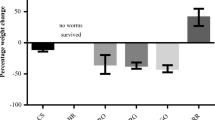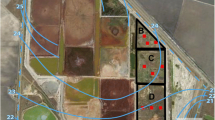Abstract
Bauxite residues can pose an environmental risk mainly because of their alkaline nature and the presence of trace elements. Phytostabilization seems to be a promising rehabilitation option and physicochemical assessment remains the primary indicator of rehabilitation success. To further understand the potential for rehabilitated residues to support both vegetation and soil faunal communities, a series of ex situ exposure tests was conducted. Plant germination, seedling development and trace element uptake were assessed using the Phytotoxkit™ approach. Avoidance and survival tests soil faunal species Eisenia foetida, Folsomia candida and Allobophora chlorotica were conducted to determine possibility of inhibition in residue soils. Unamended residue is inhibitory to plant growth and mesofaunal establishment. Amendment improves the physicochemical properties of the residue, and data revealed that both gypsum and organic addition is required to promote conditions favourable to plant growth and mesofauna establishment.
Access this chapter
Tax calculation will be finalised at checkout
Purchases are for personal use only
Similar content being viewed by others
References
Power, G., Gräfe, M. and Klauber, C., 2011. Bauxite residue issues: I. Current management, disposal and storage practices. Hydrometallurgy, 108(1–2), pp. 33–45.
Ujaczki, É., Feigl, V., Molnár, M., Cusack, P., Curtin, T., Courtney, R., O’Donoghue, L., Davris, P., Hugi, C., Evangelou, M.W. and Balomenos, E., 2018. Re‐using bauxite residues: benefits beyond (critical raw) material recovery. Journal of Chemical Technology & Biotechnology, 93(9), pp. 2498–2510.
Mayes, W.M., Jarvis, A.P., Burke, I.T., Walton, M., Feigl, V., Klebercz, O. and Gruiz, K., 2011. Dispersal and attenuation of trace contaminants downstream of the Ajka bauxite residue (red mud) depository failure, Hungary. Environmental science & technology, 45(12), pp. 5147–5155.
Olszewska, J.P., Meharg, A.A., Heal, K.V., Carey, M., Gunn, I.D., Searle, K.R., Winfield, I.J. and Spears, B.M., 2016. Assessing the legacy of red mud pollution in a shallow freshwater lake: arsenic accumulation and speciation in macrophytes. Environmental science & technology, 50(17), pp. 9044–9052.
Ren, J., Chen, J., Han, L., Wang, M., Yang, B., Du, P. and Li, F., 2018. Spatial distribution of heavy metals, salinity and alkalinity in soils around bauxite residue disposal area. Science of The Total Environment, 628, pp. 1200–1208.
Higgins, D., Curtin, T., Pawlett, M. and Courtney, R., 2016. The potential for constructed wetlands to treat alkaline bauxite-residue leachate: Phragmites australis growth. Environmental Science and Pollution Research, 23(23), pp. 24305–24315.
Tordoff, G.M., Baker, A.J.M. and Willis, A.J., 2000. Current approaches to the revegetation and reclamation of metalliferous mine wastes. Chemosphere, 41(1–2), pp. 219–228.
Ye, Z.H., Shu, W.S., Zhang, Z.Q., Lan, C.Y. and Wong, M.H., 2002. Evaluation of major constraints to revegetation of lead/zinc mine tailings using bioassay techniques. Chemosphere, 47(10), pp. 1103–1111.
Frouz, J., Elhottová, D., Kuráž, V. and Šourková, M., 2006. Effects of soil macrofauna on other soil biota and soil formation in reclaimed and unreclaimed post mining sites: Results of a field microcosm experiment. Applied soil ecology, 33(3), pp. 308–320.
Kardol, P. and Wardle, D.A., 2010. How understanding aboveground–belowground linkages can assist restoration ecology. Trends in ecology & evolution, 25(11), pp. 670–679.
Ma, Y., Dickinson, N. and Wong, M., 2002. Toxicity of Pb/Zn mine tailings to the earthworm Pheretima and the effects of burrowing on metal availability. Biology and Fertility of Soils, 36(1), pp. 79–86.
Mudrák, O., Uteseny, K. and Frouz, J., 2012. Earthworms drive succession of both plant and Collembola communities in post-mining sites. Applied soil ecology, 62, pp. 170–177.
Chapman EEV, Helmer SH, Dave G, Murimboh JD (2012) Utility of bioassays (lettuce, red clover, red fescue, Microtox, MetSTICK, Hyalella, bait lamina) in ecological risk screening of acid metal (Zn) contaminated soil. Ecotox Environ Safe 80:161–171.
Winkler D (2014) Collembolan response to red mud pollution in Western Hungary. Appl Soil Ecol 83:219–229.
Courtney R, Mullen G, Harrington T (2009) An evaluation of revegetation success on bauxite residue. Restor Ecol 17:350–358.
Jones, B.E., Haynes, R.J. and Phillips, I.R., 2011. Influence of organic waste and residue mud additions on chemical, physical and microbial properties of bauxite residue sand. Environmental Science and Pollution Research, 18(2), pp. 199–211.
Xue, S., Zhu, F., Kong, X., Wu, C., Huang, L., Huang, N. and Hartley, W., 2016. A review of the characterization and revegetation of bauxite residues (Red mud). Environmental Science and Pollution Research, 23(2), pp. 1120–1132.
Lowe, C.N. and Butt, K.R. Culture techniques for soil dwelling earthworms: a review. Pedobiologia, 49 (2005) 401–413.
Zhu, F., Xue, S., Hartley, W., Huang, L., Wu, C. and Li, X., 2016. Novel predictors of soil genesis following natural weathering processes of bauxite residues. Environmental Science and Pollution Research, 23(3), pp. 2856–2863.
Gräfe, M. and Klauber, C., 2011. Bauxite residue issues: IV. Old obstacles and new pathways for in situ residue bioremediation. Hydrometallurgy, 108(1–2), pp. 46–59.
Courtney, R., Keith, A.M. and Harrington, T., 2011. Nematode assemblages in bauxite residue with different restoration histories. Restoration Ecology, 19(6), pp. 758–764.
Courtney, R. and Mullen, G., 2009. Use of germination and seedling performance bioassays for assessing revegetation strategies on bauxite residue. Water, air, and soil pollution, 197(1–4), pp. 15–22.
Courtney, R. and Harrington, T., 2012. Growth and nutrition of Holcus lanatus in bauxite residue amended with combinations of spent mushroom compost and gypsum. Land Degradation & Development, 23(2), pp. 144–149.
Qin J, Hovmand MF, Ekelund F, Rønn R, Christensen S, de Groot GA, Mortensen LH, Skov S, Krogh PH (2017) Wood ash application increases pH but does not harm the soil mesofauna. Environ Pollut 224:581–589.
Domene X, Colón J, Uras MV, Izquierdo R, Àvila A, Alcañiz JM (2010) Role of soil properties in sewage sludge toxicity to soil collembolans. Soil Biol Biochem 42:1982–1990.
Owojori OJ, Reinecke AJ, Voua-Otomo P, Reinecke SA (2009) Comparative study of the effects of salinity on life-cycle parameters of four soil-dwelling species (Folsomia candida, Enchytraeus doerjesi, Eisenia fetida and Aporrectodea caliginosa). Pedobiologia 52:351–360.
Southwell, L.T. and Majer, J.D. The Survival and Growth of the Earthworm Eisenia foetida(Lumbricidae: Oligochaeta) in Alkaline Residues Associated With the Bauxite Refining Process. Pedobiologia, 23 (1982) 42–52.
Hamdy, M.K. and Williams, F.S. Bacterial amelioration of bauxite residue waste of industrial alumina plants. J. Ind. Microbiol. Biot. 27(2001) 228–233.
Owojori, O.J., Reinecke, A.J. and Rozanov, A.B. Effects of salinity on partitioning, uptake and toxicity of zinc in the earthworm Eisenia fetida. Soil Biol. Biochem. 40 (2008) 2385–2393.
Finnegan G, O’ Grady, A and Courtney R Plant assays and avoidance tests with collembola and earthworms demonstrate rehabilitation success in bauxite residue Environ. Sci. Pollut. R. (2018) 25 (3), 2157–2166.
Nirola, R., Megharaj, M., Venkateswarlu, K., Aryal, R., Correll, R. and Naidu, R. Assessment of metal toxicity and bioavailability in metallophyte leaf litters and metalliferous soils using Eisenia fetida in a microcosm study. Ecotox. Environ. Safe. 129(2016) 264–272.
Courtney R, Di Carlo E, Schmidt O Soil properties and earthworm populations associated with bauxite residue rehabilitation strategies. Environ. Sci. Pollut. R. (2018). https://doi.org/10.1007/s11356-018-3973-z.
Author information
Authors and Affiliations
Corresponding author
Editor information
Editors and Affiliations
Rights and permissions
Copyright information
© 2019 The Minerals, Metals & Materials Society
About this paper
Cite this paper
Di Carlo, E., Courtney, R. (2019). An Ecological Approach to the Rehabilitation of Bauxite Residue. In: Chesonis, C. (eds) Light Metals 2019. The Minerals, Metals & Materials Series. Springer, Cham. https://doi.org/10.1007/978-3-030-05864-7_12
Download citation
DOI: https://doi.org/10.1007/978-3-030-05864-7_12
Published:
Publisher Name: Springer, Cham
Print ISBN: 978-3-030-05863-0
Online ISBN: 978-3-030-05864-7
eBook Packages: Chemistry and Materials ScienceChemistry and Material Science (R0)




